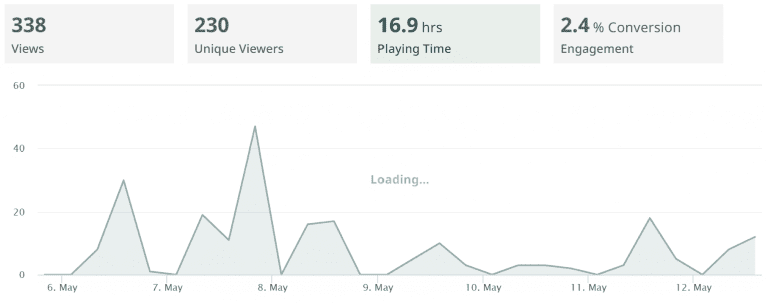The Messy Truth: How Streamer Monetization Affects The Viewer Experience

Table of Contents
The Impact of Advertising on Viewer Experience
Advertising is a cornerstone of many streaming platforms' revenue models, but its implementation significantly impacts viewer experience. The type, frequency, and intrusiveness of ads all contribute to viewer satisfaction (or dissatisfaction).
Types of Ads and Their Intrusiveness
Different ad formats have varying levels of impact. Pre-roll ads (before content), mid-roll ads (during content), and banner ads (on-screen) all compete for viewer attention. Pre-roll ads, while often skippable, can still be irritating, especially if lengthy. Mid-roll ads interrupt the viewing flow, potentially breaking immersion and causing frustration. Banner ads, though less disruptive, can still be visually distracting, reducing the overall enjoyment of the content. Un-skippable ads, the bane of many viewers, are particularly disruptive and often lead to negative experiences. The frequency of ads is also a crucial factor. Too many ads, regardless of type, create a poor viewing experience and can drive viewers away.
The Effectiveness of Ad-Blockers and Their Implications
The prevalence of ad-blockers highlights viewers' dissatisfaction with excessive or intrusive advertising. The widespread use of ad-blocking software directly impacts streamer revenue, forcing them to explore alternative monetization strategies. This creates an ongoing arms race between streamers employing increasingly sophisticated ad techniques and ad-blocker developers constantly improving their blocking capabilities. This constant battle pushes innovation, potentially leading to alternative monetization methods that are both less intrusive and more effective.
- Examples of intrusive ad experiences: Many viewers cite Hulu and other ad-supported platforms as having excessive or poorly implemented ad breaks.
- Viewer complaints regarding ads: Common complaints include un-skippable ads, too many ads, and ads that are irrelevant or offensive.
- Impact of personalized ads on privacy concerns: The use of personalized ads raises significant privacy concerns for many viewers.
Subscription Models and Their Limitations
Subscription models offer a more seamless viewing experience by eliminating ads, but they present their own set of challenges. The complexity of these models can be confusing and frustrating for viewers.
The Variety of Subscription Tiers and Their Value
Streaming services often offer different subscription tiers, each with varying features and price points. Comparing these tiers across platforms (Netflix, Hulu, Disney+, Amazon Prime Video, etc.) reveals significant disparities in value. A basic tier might offer limited resolution or lack access to certain content, while higher tiers can be expensive, leading to questions about their true value. Price increases, a common strategy to boost revenue, often lead to viewer dissatisfaction and potential churn.
Subscription Fatigue and the Problem of Choice
The proliferation of streaming services has created "subscription fatigue," a situation where consumers are overwhelmed by the sheer number of choices and the associated costs. Choosing the "right" platform with the desired content can be a time-consuming and often frustrating process. This phenomenon is often linked to the "cord-cutting" trend, where viewers cancel traditional cable subscriptions but end up paying for multiple streaming services, sometimes exceeding their previous cable bill.
- Examples of different subscription models: Netflix's basic, standard, and premium plans illustrate the tiered approach, with differences in resolution and simultaneous streams. Hulu offers ad-supported and ad-free plans.
- Instances of subscriber churn: Price hikes from streaming services often trigger subscriber losses as viewers seek cheaper alternatives.
- Trend of bundled streaming services: To combat subscription fatigue, some providers offer bundled packages, combining different services at a discounted rate.
Alternative Monetization Strategies and Their Effects
Recognizing the limitations of ads and subscriptions, streamers are increasingly exploring alternative monetization strategies. These methods often involve a more direct relationship with viewers but also raise ethical considerations.
Affiliate Marketing and Sponsored Content
Affiliate marketing and sponsored content are becoming increasingly common. Streamers might subtly integrate products into their content or mention brands in their commentary. While often less intrusive than ads, the lack of transparency can be concerning. Viewers might not always realize when they are watching sponsored content, potentially undermining the authenticity of the streamer and their content. The line between organic content and paid promotion can be blurred, raising ethical questions.
Donations and Paid Subscriptions (Patreon, Twitch)
Platforms like Patreon and Twitch allow viewers to directly support creators through donations or paid subscriptions. This model fosters a stronger community aspect, with viewers feeling more connected to the streamer. However, relying on donations can be precarious, and maintaining consistent support from viewers is a constant challenge for streamers. This pressure can lead to streamer burnout, affecting the quality and consistency of their content.
- Positive and negative aspects of alternative methods: While affiliate marketing can provide income, it can impact authenticity. Donations build community but lack consistency.
- Ethical considerations of influencer marketing: Transparency is paramount for ethical influencer marketing in streaming.
- Impact on content authenticity: Over-reliance on sponsored content can compromise the authenticity and integrity of the streamed content.
Conclusion
Streamer monetization is a multifaceted issue with significant consequences for the viewer experience. While necessary for the survival of streaming platforms and creators, the current landscape often involves a trade-off between profitability and viewer satisfaction. Intrusive ads, complex subscription models, and the ethical considerations surrounding alternative monetization strategies all demand careful consideration. Finding a balance that allows streamers to thrive while providing viewers with a positive and enjoyable experience remains a crucial challenge in the evolving world of online entertainment. To learn more about effective and ethical streamer monetization strategies and their effect on you, continue exploring resources on [link to relevant resource]. Understanding the complexities of streamer monetization is key to navigating the ever-changing world of online video.

Featured Posts
-
 I Pretended To Be A Missing Girl A Viral Reddit Story
May 22, 2025
I Pretended To Be A Missing Girl A Viral Reddit Story
May 22, 2025 -
 Mission Patrimoine 2025 En Bretagne Focus Sur La Restauration De Plouzane Et Clisson
May 22, 2025
Mission Patrimoine 2025 En Bretagne Focus Sur La Restauration De Plouzane Et Clisson
May 22, 2025 -
 Original Sin Season 1 Finale A Deeper Look At Dexters Debra Morgan Error
May 22, 2025
Original Sin Season 1 Finale A Deeper Look At Dexters Debra Morgan Error
May 22, 2025 -
 New Challenger Aims To Break Trans Australia Run Record
May 22, 2025
New Challenger Aims To Break Trans Australia Run Record
May 22, 2025 -
 Luxury Car Sales In China The Bmw And Porsche Case Study
May 22, 2025
Luxury Car Sales In China The Bmw And Porsche Case Study
May 22, 2025
Latest Posts
-
 Significant Zebra Mussel Presence Detected On Casper Boat Lift
May 22, 2025
Significant Zebra Mussel Presence Detected On Casper Boat Lift
May 22, 2025 -
 Casper Boat Owner Uncovers Massive Zebra Mussel Infestation
May 22, 2025
Casper Boat Owner Uncovers Massive Zebra Mussel Infestation
May 22, 2025 -
 Zebra Mussel Infestation Found On Boat Lift In Casper Wyoming
May 22, 2025
Zebra Mussel Infestation Found On Boat Lift In Casper Wyoming
May 22, 2025 -
 Become A Wyoming Guided Fishing Advisory Board Volunteer
May 22, 2025
Become A Wyoming Guided Fishing Advisory Board Volunteer
May 22, 2025 -
 New Documentary The Impact Of Winter On Pronghorn And The Human Response
May 22, 2025
New Documentary The Impact Of Winter On Pronghorn And The Human Response
May 22, 2025
